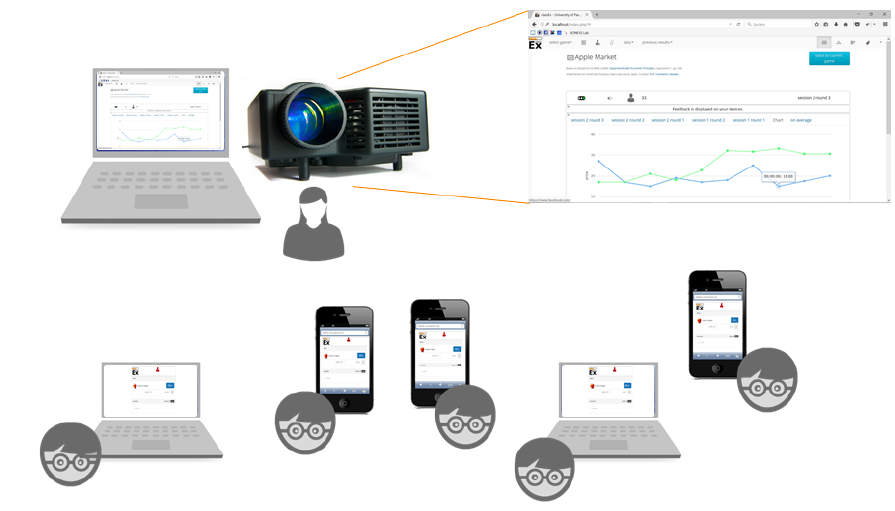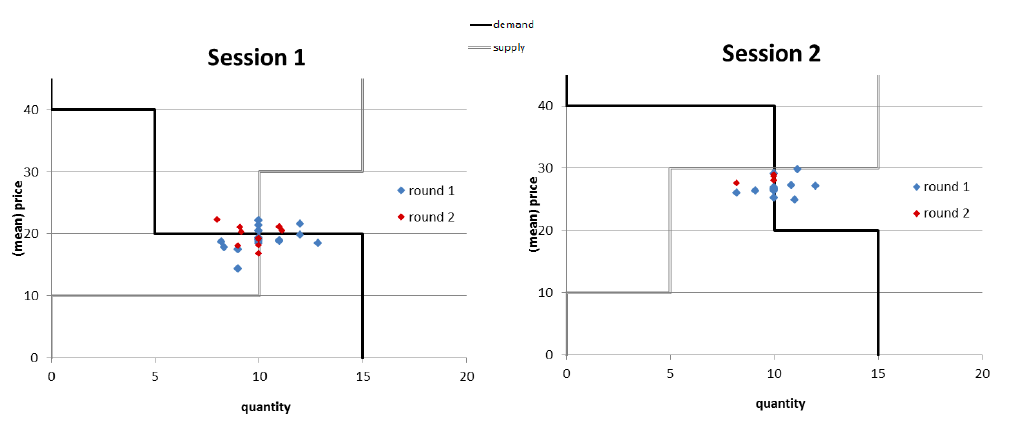What is the best method of using experiments on economic concepts in the classroom? In their BSE Working Paper (No. 996), “Teaching microeconomic principles with smartphones – lessons from classroom experiments with classEx,” Marcus Giamattei and Humberto Llavador discuss the role of experiments in teaching economic concepts to students and their experience with conducting them through the online platform classEx, established at the University of Passau.
Classroom experiments in Economics
Classroom experiments as a teaching tool increase understanding and especially motivation. Economic ideas come to life in the classroom for students who take part in experiments. Those who have just participated in an experiment and have seen the data are interested to discover for themselves how well (or poorly) the theory works to explain the reality that they have observed. They also observe how other students act and the adjustment process to equilibrium, aspects difficult to convey in a lecture.
Traditionally, experiments have been successfully pursued using pen-and-paper or in a computer lab by many economics instructors and academics. However, pen-and-paper is time and resource consuming, while experiments in the lab require appropriate installations and impede a direct interaction among students. Consequently, the adoption of experiments in the classroom is still far from being the dominant way to disseminate ideas to students.
In this paper, Giamattei and Llavador discuss their experience in conducting experiments using a free online tool called classEx. The authors created fully elaborated packages in classEx to run a complete course in microeconomic principles using face-to-face experiments with mobile devices. The experiments were based on Bergstrom-Miller (2000) and the packages were used at Universitat Pompeu Fabra (UPF) with over 500 undergraduate students in the fall of 2016.
Interactive Experiment with classEX
classEx (www.classEx.de) is a free web-based online tool for running classroom experiments. It runs as a centralized application where lecturers and students log in via their browser. Instructions, public information, and the data generated while running the experiment can be projected in the classroom for all students. Private information and decisions are displayed on the students’ mobile devices. Figure 1 below displays an overview of the classEx interface and operation.
Lecturers can start right away and play any of the pre-programmed experimental games or create their own games and modify existing ones. It provides instructors with the flexibility to adapt any game to their needs or use existing games as a starting point for the design of new ones. classEx allows for in-class experiments with face-to-face interaction, even for large groups, while avoiding the problems usually associated with them, like time-consuming, record keeping, or entering experimental data.

The Bergstrom-Miller Approach
Their teaching proposal combines elements of a flipped-classroom and experiential learning with the use of experiments in the classroom. Each topic is structured in three stages as shown in Figure 2. Firstly, experiments are run in small groups and become the key-learning tool. Each experiment is preceded by a preparation phase with a few warm-up questions. Discussion takes place during and after the experiment, inviting students to come up with possible explanations for the observed results. This is followed by students working on a series of constructive homework using the data obtained in the experiment to discover the main concepts by themselves. The approach emphasizes the importance to furnish classroom experiments with constructive homework, making students reflect on the experiment and analyze the data. Finally, the instructor generalizes the analysis, provides applications, and solves the problems that students had while working on the homework.

Implementing the Bergstrom-Miller Approach with classEx at UPF: Two Examples
In this paper Giamattei and Llavador discuss in detail two representative experiments among the ones used in the Introduction to Microeconomics course at UPF.
Example 1: Supply and Demand Experiment
The Supply and Demand experiment is possible the most widely used experiment in the classroom. Sellers and buyers try to trade a commodity, in their case bushels of apples. Students move around in the classroom and discuss prices. If they reach an agreement, they formalize it via classEx. Figure 3 depicts the demand, supply and equilibrium for a group of 30 students. The figure also shows the resulting averages per group in both rounds of session 1. Overall, average choices were quite close to equilibrium in both rounds and students were able to quickly converge around equilibrium prices.

Students learned that not everybody participates in a transaction (at equilibrium) and, more importantly, that the concept of equilibrium price is a construction that approximates (albeit very close) observed market prices. Problem sets and lectures consolidate these observations and explain the transition from step to smooth supply and demand functions, but the deep understanding and the intuition was already there from their participation in the experiment.
Example 2: The Fish Market with Sunk Cost
This is a variation of the Supply and Demand experiment, with the difference that all sellers have a $10 sunk cost and the same marginal cost, equal to zero. In the first session, sellers only have 1 unit of supply. The second session floods the market with fish, each seller has 3 units to supply, causing the price to crash close to 0 (Figure 4). Fishermen learn, slowly but pretty surely, that they are better off selling fish below average cost than not selling them at all; and most, if not all, fishers are unable to recover the sunk cost and end up with losses. Through this experiment, instructors were able to convey complex ideas of equilibrium existence and close to 0 prices, and to relate the results with real life experiences like crop destruction by farmers or the evolution of the price of carbon during Phase 1 of the EU Emission Trading System.

Conclusion
In essence, the authors in this paper have tried to convey utility of classEx, a free online tool that enables instructors to run face-to-face experiments in the classroom. Besides the benefits of using experiments as a teaching tool, the authors find that the use of classEx substantially reduces the time devoted to running experiments, allowing for lengthier discussion of the results while eliminating the use of printed-paper and automatizing data collection, and hence facilitating its adoption. They also find that students could naturally motivate and internalize complex ideas difficult to compel in a lecture. Further, conducting experiments using classEx resulted in increased motivation of students as well as of instructors, making teaching more effective and efficient.


